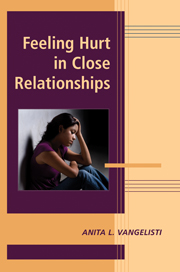Book contents
- Frontmatter
- Contents
- List of Contributors
- Foreword
- PART I INTRODUCTION
- PART II CONCEPTUALIZING HURT
- 2 The Nature of Hurt Feelings: Emotional Experience and Cognitive Appraisals
- 3 Thinking the Unthinkable: Cognitive Appraisals and Hurt Feelings
- 4 Adding Insult to Injury: The Contributions of Politeness Theory to Understanding Hurt Feelings in Close Relationships
- 5 Rejection Sensitivity: A Model of How Individual Difference Factors Affect the Experience of Hurt Feelings in Conflict and Support
- 6 Understanding and Altering Hurt Feelings: An Attachment-Theoretical Perspective on the Generation and Regulation of Emotions
- PART III HURTFUL ACTS
- PART IV HURT IN RELATIONAL CONTEXTS
- PART V HURT IN APPLIED CONTEXTS
- Author Index
- Subject Index
- References
5 - Rejection Sensitivity: A Model of How Individual Difference Factors Affect the Experience of Hurt Feelings in Conflict and Support
from PART II - CONCEPTUALIZING HURT
Published online by Cambridge University Press: 04 August 2010
- Frontmatter
- Contents
- List of Contributors
- Foreword
- PART I INTRODUCTION
- PART II CONCEPTUALIZING HURT
- 2 The Nature of Hurt Feelings: Emotional Experience and Cognitive Appraisals
- 3 Thinking the Unthinkable: Cognitive Appraisals and Hurt Feelings
- 4 Adding Insult to Injury: The Contributions of Politeness Theory to Understanding Hurt Feelings in Close Relationships
- 5 Rejection Sensitivity: A Model of How Individual Difference Factors Affect the Experience of Hurt Feelings in Conflict and Support
- 6 Understanding and Altering Hurt Feelings: An Attachment-Theoretical Perspective on the Generation and Regulation of Emotions
- PART III HURTFUL ACTS
- PART IV HURT IN RELATIONAL CONTEXTS
- PART V HURT IN APPLIED CONTEXTS
- Author Index
- Subject Index
- References
Summary
Everyone experiences hurt feelings in close relationships – a mother publicly criticizes her daughter, a boyfriend doesn't offer to pick his girlfriend up from the airport, or a woman chooses not to confide in her best friend. Although hurt feelings can be experienced in any interpersonal context, they are more likely to occur in close relationships. What leads to hurt feelings may differ for individuals, but studies highlight several commonalities. “Feeling hurt” has been conceptualized as an emotional interpersonal response (Leary, Springer, Negel, Ansell & Evans, 1998; Vangelisti, 1994) to a devaluation (Leary et al., 1998) or relational transgression (Vangelisti, 2001). One can respond to hurt feelings in both constructive (i.e., increasing understanding of one's partner) and unconstructive ways (e.g., lashing out in anger). Maladaptive responses to feeling hurt can have negative consequences including lower self-esteem and relational distancing (Vangelisti, 2001) or retaliation (Ayduk, Downey, Testa, Yen, & Shoda, 1999).
Hurtful events may occur more frequently to or be felt more intensely by some individuals than others. A teenager may interpret ridicule as the end of the world, whereas a 30-year-old may be more poised to shrug it off. The new kid in school may find himself the subject of bullying more often than his classmates. Individual differences in personality dispositions can also explain some of the variability in hurtful experiences and responses to them. This variability can have significant consequences for emotional and physical health (see Loving, Le, and Crockett, Chapter 17, this volume).
- Type
- Chapter
- Information
- Feeling Hurt in Close Relationships , pp. 73 - 91Publisher: Cambridge University PressPrint publication year: 2009
References
- 4
- Cited by

